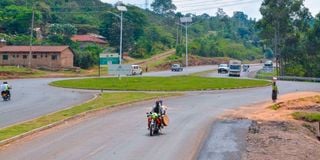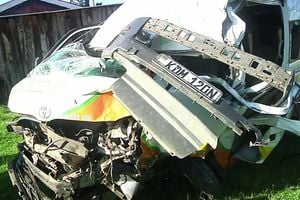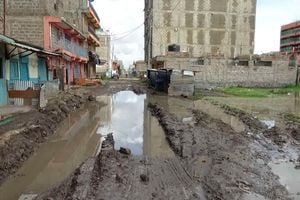
A view of the Coptic roundabout along Kisumu-Kakamega Highway on July 17, 2024. The area has become a deadly blackspot.
A simple search on the Internet for the words 'Coptic roundabout' yields disturbing accident stories.
"Three killed, five injured after lorry driver loses control; Chavakali Boys High School student killed as bus overturns; Three die after lorry overturns on Kisumu-Kakamega Road; One dead, 46 injured as Uzima University bus crashes,” the disheartening search results show.
One would be forgiven for calling it 'an online graveyard'.
Top on the search list is the July 15 accident involving a bus belonging to Uzima University, which was carrying students and members of staff who were going on an academic trip. The vehicle overturned killing a worker and injuring 46 others.
The driver is said to have lost control of the vehicle while trying to navigate the Coptic roundabout, the car veered off the road and landed into a ditch.
The 46 injured passengers were taken to Jaramogi Oginga Odinga Teaching and Referral Hospital for treatment, while the body of the deceased was taken to hospital’s mortuary.
The Uzima University accident is the second to occur at the roundabout in less than two weeks.

A view of the Coptic roundabout along Kisumu-Kakamega Highway on July 17, 2024.
On July 3, three people died while five others were taken to Jaramogi Oginga Odinga Teaching and Referral Hospital in critical condition after a lorry heading to Kisumu from Vihiga overturned at the roundabout.
On April 1, Chavakali Boys High School student Joseph Mwadulo died on the spot after an Easy Coach bus he was travelling in together with his schoolmates was involved in a road accident at the same place. Several other students were injured. The bus had been hired to ferry the learners to Nairobi after the school closed for the April holidays.
The bus driver, George Onyango Riako, was arrested and charged at Winam Law Courts in Kisumu with causing the death of the learner. He faced an additional nine counts of causing injury to nine students through reckless driving.
In 2022, three people died and three others sustained injuries after a lorry that was transporting sugar overturned at the same spot.
In 2018, five people were killed while 12 others sustained serious injuries after a matatu heading to Kisumu rolled at the roundabout.
The roundabout got its name from the nearby Holy Ghost Coptic Church associated with controversial preacher, Father John Pesa 1.
It’s located near Riat Hills on the dual carriageway that connects Kisumu and Vihiga counties.
Poor road signage
Locals attribute the high number of road accidents at the roundabout to poor road design, lack of proper and clear signage and reckless driving.
“The accidents are one too many. The accidents mainly involve lorries or buses heading towards Kisumu,” said Francis Masasa who lives in the Coptic Church compound.

A view of the Coptic roundabout along Kisumu-Kakamega Highway on July 17, 2024.
Mr Masasa said for the two years he has lived in the area he has witnessed several accidents, adding that some could have been avoided if the roundabout was removed.
He said that nearly all the accidents that occur at the spot do not involve a collision between two vehicles, but the crashes are usually self-inflicted.
“The accidents usually involve trucks or buses overturning. We have also realised that most of the vehicles always overturn when they are halfway the roundabout,” he said, adding that the guard rails erected on the side of the road have also been destroyed due to the accidents.
In an interview with Nation.Africa, David (not his real name) whose vehicle was recently involved in an accident at the infamous roundabout, blamed the crashes on poor road design.
He recalled driving a bus down the road from the direction of Riat Hills and lost control upon reaching the roundabout.
“The road is so steep and therefore navigating the roundabout is quite challenging. I remember our vehicle veering off the road after hitting a road kerb and landing on its side,” he said.
This came as a surprise to David who had used the countless times without any difficulties.
David is one of the people who believe that the roundabout should be removed in order to prevent future accidents.
“While smaller cars are not affected, whenever we are driving down the road from Vihiga, negotiating the roundabout remains a challenge. They should either do away with the roundabout it or reduce its circumference to increase the outer space where cars pass,” he said.
But the Kenya National Highways Authority (KeNHA) Nyanza Regional Director Julius Mak’Odero said that while the Kakamega-Kisumu Road was initially meant to be a single carriageway, the move to transform it to a dual carriageway was inspired by road safety concerns.
“What we realised upon completion is that motorists using the road became excited about the upgrade and lowered their guard. Driving at higher speeds while paying very little attention to road safety rules results into accidents,” explained Mr Mak’Odero.
He added: “In the past, drivers were more careful on the single carriageway and were alert, but with the upgrade, some are easily distracted or others drive while using their phones.”
Survey
The engineer said that after conducting their own research, they discovered that most of the accidents at the roundabout involved heavy commercial vehicles such as trailers, lorries, and buses.
He said that this has been worsened by the extended distance between the Coptic roundabout and the next roundabout at Kona Mbaya, something he said encouraged motorists to speed.
“A driver cannot navigate a roundabout at a speed of 100 kilometers per hour, in such cases, the brakes are likely to fail resulting in accidents,” he said.
Mr Mak’Odero, however, cautioned that removing the roundabout is not an option since the drivers will have a longer free flow, which may be risky to oncoming vehicles and other road users.
He further explained that the roundabout design is per the required standards which includes three lanes granting the vehicles a bigger turning radius.
“We also have an option of introducing more bumps, but that will reduce the level of service satisfaction for road users, while increasing stress to the pavement and road maintenance cost.
"The worst part of introducing more bumps is that since we are dealing with trucks and buses, the vehicles are likely to lose stability at the roundabout and result in more accidents,” Mr Mak’Odero said.
New safety measures
In an effort to reduce the accidents around the roundabout, the KeNHA regional boss said that they will introduce road signs, markings and rumble strips to control speed.
“What we are doing from July 17 is that we are going to retain the roundabout, but will introduce two sets of rumble strips and road markings at different intervals which will act as a warning ahead of the roundabout,” he said.
Mr Mak’Odero also said that they are conducting road safety campaigns for road users.







